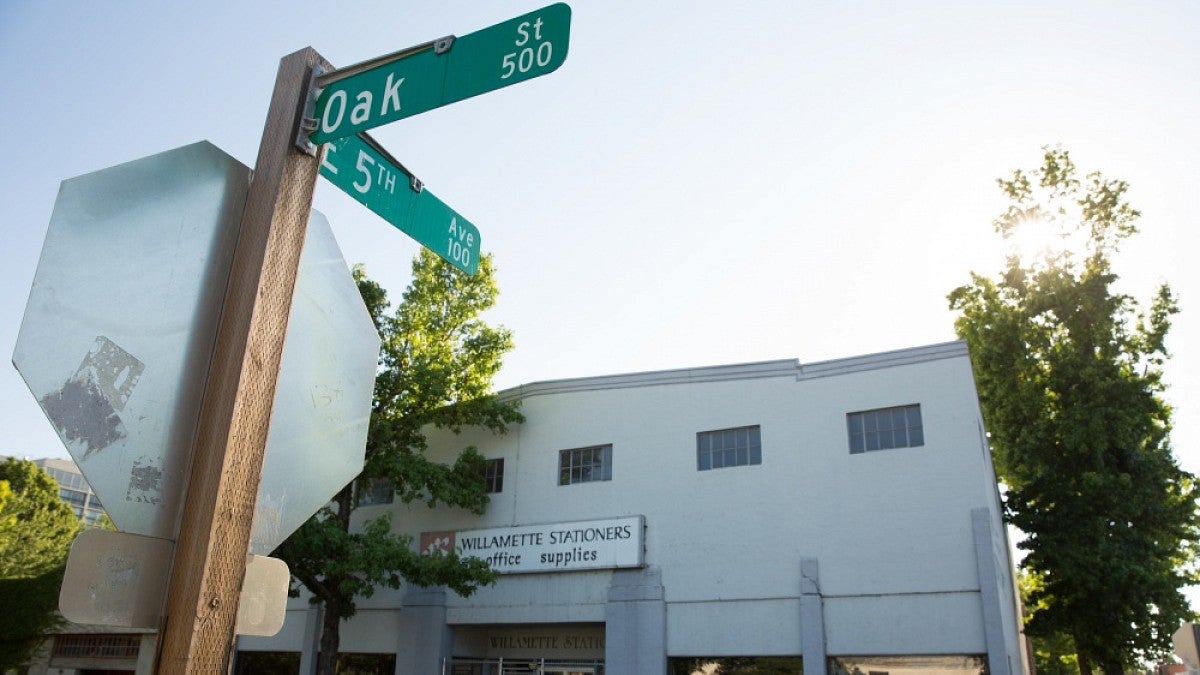The concentration of creative activity in downtown Eugene will soon get deeper with the arrival of dozens of faculty members from the School of Art + Design, part of the UO’s College of Design, in the former Willamette Stationers building.
The University of Oregon recently purchased the building at 510 Oak St. and will convert it into studios. Faculty will move into the renovated space in September 2018.
“I am delighted that we were able to make this investment in the creative work of our design faculty,” President Michael H. Schill said. “Despite the financial constraints facing us, we remain as committed as ever to furthering the creative work of our students and faculty. I am delighted that we were able to make this permanent commitment to our art and design faculty.”
The siting of the new studios right in the middle of downtown Eugene occurred through a combination of foresight and serendipity. Over the past several years, the College of Design has explored moving some of its activities into the downtown area. One of the first of these moves was the Department of Product Design, which moved into the newly opened Innovation Hub at 942 Olive St. last year.
About a year ago, the need for a new home for art and design studios became clear as a result of the development of the Phil and Penny Knight Campus for Accelerating Scientific Impact on the north side of Franklin Boulevard and the expiration of leases at another site. With some School of Art + Design faculty members needing to be relocated, the College of Design worked closely with Office of Academic Affairs and the Department of Finance and Administration leadership to find a permanent solution that would enable faculty to further their individual and communal objectives.
“We are seizing this opportunity and making an important investment that demonstrates our commitment to the arts and humanities at UO,” said Jayanth Banavar, provost and senior vice president. “Bringing these incredibly talented art and design faculty members together will create an energy that will be palpable, and I believe the new facility, which will include an art gallery, will be a wonderful asset for the entire community.”
It is the first major change to be announced since UO’s School of Architecture and Allied Arts was renamed the College of Design on July 1. The School of Art + Design is one of three schools within the college and it offers degrees in an array of fine arts, including digital media, ceramics, fibers, jewelry and metalsmithing, photography, painting, printmaking,and sculpture as well as product design.
“As we explored options, we began to realize that with an investment from the university and the college, and a pooling of dollars that were being used to pay for studio and office space across the city, we could create the kind of artistic space that will be a huge benefit to the work of our faculty members,” said Christoph Lindner, dean of the College of Design. “To say they are excited would be an understatement.”
Laura Vandenburgh, head of the School of Art + Design and associate professor of art, said faculty are thrilled about the new development.
“The old Willamette Stationers building is a perfect fit for us; it is a wonderful old building in a lively part of town and we look forward to renovating and inhabiting it in new ways,” she said. “This represents a landmark moment; bringing faculty studios into one place will make 510 Oak a kind of think tank for art and design practice and allow us to better connect with the larger community. A downtown building dedicated to art and design research — where colleagues can work alongside one another and share our work with visiting critics, curators, artists, designers and the community — will catalyze and extend the work of our remarkable faculty.”
Purchased for $1.84 million, the university and the college will ultimately invest a total of $5 million in the facility to create 24 studios, a gallery and a workshop in the roughly 14,000-square-foot structure near the heart of downtown Eugene.
“We are excited that this building will create opportunities for collaboration and community engagement around creative practice and research, while aligning with our desire to be active and visible in downtown Eugene,” Lindner added.
The studios at 510 Oak St. will soon be joined by a second major new arts facility at the UO. In October, the university will open the newly constructed Berwick Hall, which will become home to the Oregon Bach Festival.
“The University of Oregon enjoys a proud tradition of being the bastion of liberal arts in the state of Oregon,” Schill said. “Our investment in 510 Oak St. and the Berwick’s wonderful gift of Berwick Hall demonstrate our continuing commitment to that vision.”
The $9 million, 10,000-square-foot Berwick Hall, located near the MarAbel B. Frohnmayer Music Building on the UO campus, will serve the Oregon Bach Festival’s expanding programs and create more opportunities for collaboration with the UO School of Music and Dance. The Berwick family’s generosity also funded the birth of the namesake Berwick Academy, which is one of America’s few residencies for top-flight young professionals specializing in historically informed performance practice.
“Andy and Phyzz (Berwick) are remarkable members of our University of Oregon family and we are incredibly grateful to them for the magnificent gift of Berwick Hall,” Schill said. “As state investments in our public universities decline, we increasingly must rely upon philanthropy to support all aspects of the university. This is equally important in the arts as it is in the sciences. Andy and Phyzz understand this.”
— By Tobin J. Klinger, University Communications


